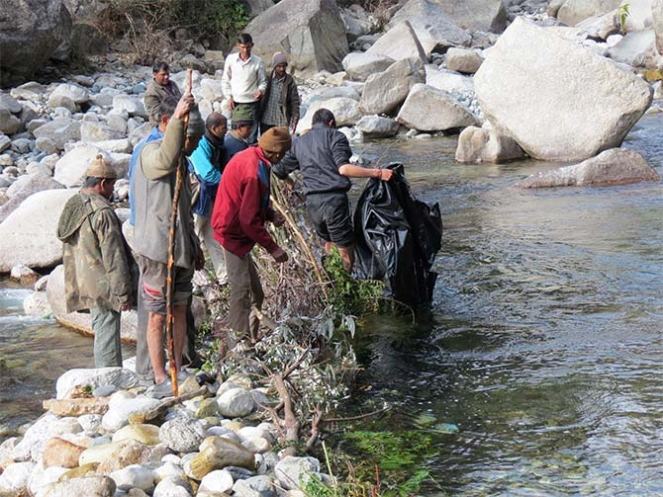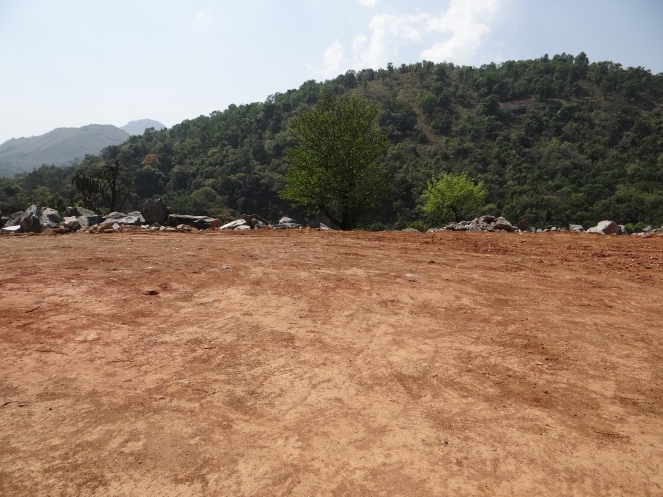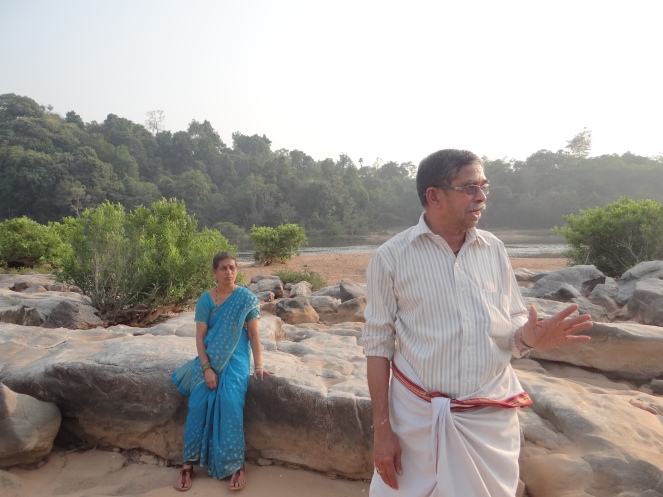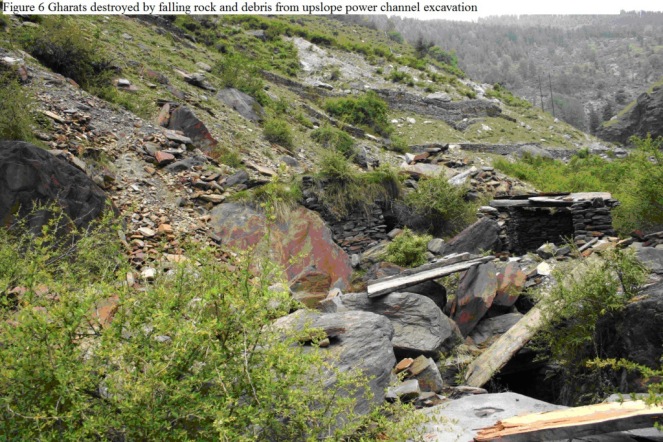As Prime Minister Narendra Modi inaugurated the RE-Invest 2015, India’s first Renewable Energy Global Investors’ Meet and Expo in New Delhi on February 15, 2015, full-page advertisements in the National Capital declared the target of adding 5000 MW of small hydro capacity by 2022, in addition to other renewable energy targets. A part of this renewed focus on small hydro, a subset of India’s new push for Renewable Energy, involves a new Mission for Small Hydro Projects. Even as it has some welcome features, the new Mission will not help if the government continues to ignore significant social and environmental impacts of small hydro projects.
In a first of its kind development, the Ministry of New and Renewable Energy (MNRE) has brought out a Draft Mission Document for Small Hydro Projects in February 2015.[1] By MNRE’s definition, Small Hydel Projects (SHPs) include hydel projects between installed capacities of 0-25 MW. Those between 0-100 Kilowatt are classified as Micro Hydel, between 101-2000 (20 MW) are Mini Hydel and those between 2001-25000 (25 MW) are Small Hydel Projects (SHP). This term is also used for the entire sector (0-25 MW).
This is the first time that the sector has a dedicated Mission to further its development. The Mission is complimented by a ‘Scheme for Small Hydro’[2] for the 12th Plan period which provides generous support to state owned SHPs and indirect boost to private sector SHPs.
As per the Mission, its objective is to[3]: “address issues responsible for decline of SHP sector in the country and to regenerate interest of private sector to make investment in this sector.” It plans to achieve 500 MW of capacity in next two years and add 4500 MW in the next three years. The Mission aims at “technology development and setting up 1000 MW SHP projects on canal drops, dam outlets and water outfall structures by 2019. It would help the State Governments to renovate old SHP projects and improve their capacity and efficiency.”
The mission will be launched on 1st April 2015 and MNRE is inviting comments of the Draft statement by 4th March 2015.[4]
Some welcome aspects This is a welcome step as several hydel projects associated with dams as well as older SHPs are in state of disrepair and their revival would mean optimal use of existing infrastructure where social, environmental and economic costs have been paid. This process may also increase the generation from existing projects and also throw up the need to decommission unviable projects. For example, the 15 MW Gumti hydropower project (this will come under SHP sector since its installed capacity is less than 15 MW and hydropower is the only objective of the project) in Tripura with 30 m high and 103 m long dam submerged 4634 ha of land displaced some 40 000 people, but the project is not generating even at design level. A credible evaluation of existing SHPs can throw up the conclusion that projects like Gumti reservoir should be decommissioned.
The Mission objective in this context is (para 3.2(III)): “Evaluation of all existing Government sector small hydro projects with a view to Renovate, Modernize and uprate (RMU) them, if required, to improve efficiency and add capacity where ever possible”. The question is why should this be restricted only to government sector?
In fact the mission should also try to assess the possibility of adding hydro component to existing large dams in India. Out of some 5100 large dams, some 97% have no hydro component. Since in these projects all the costs have already been paid, it may be good idea to explore the possibility of adding hydro component.
It also aims to develop 5000 water mills/micro hydro projects and establishing local mini grids for energy security of rural region not connected to grid, which too is a welcome step towards local power security[5]. This is certainly welcome. In fact the Mission needs to find ways to incentivise and promote community owned and operated micro hydro projects since they have the potential of providing electricity to those that do not have access to it and also provide local employment opportunity. Indeed it is only the micro hydro projects that can achieve what the mission wants to achieve: “The projects have potential to meet power requirements of remote and isolated areas.”

The mission says (para 1.2) “New technologies of hydro kinetic turbines are opening avenues to setup small size power projects using flowing velocities of flowing water in rivers and canals.” This too is welcome. Use of Hydro kinetic turbines to generate power from flowing water without building any dams needs to be explored. It is also known to have some impacts on the fish, but the new technique could be useful in canals and some of the rivers.
The Mission says (para 4.10) “The Mission would commission country wide study to collect information about all old state sector projects along with generation details, status of health of project and make project vise techno-economic feasibility report to take a decision about R&M of the project.” Such a study is indeed required, but would need to be done through a credible independent agency that has no conflict of interest.
Need for the Mission: According to the statement, SHP Sector has a potential of generating 20,000 MW of power (It is not clear what the source of this figure is, the CEA had earlier assessed this to be 15000 MW). So far(by Dec 2014), 1,001 small hydropower projects of 3,832 MW have been set up in the country, of which 320 projects of 1662 MW are from private developers. There has been an increase of about 150% in the SHP installed capacity during 2000-2010 and 284 MW per year growth during the 11th Plan. There is declined to about 170 MW in the year 2013-14. This dip seems to be one of the main motivations behind the mission.
According to the Draft Mission statement, the SHP sector in the country is largely private-sector driven and the sector is witnessing some problems since 2013 which include:
- Increasing costs of projects and unattractive tariff to the power generated from SHP projects which is unable to support expenses.
- Low rate of average pool power purchase rate in hydro-rich states and non-sale of Renewable Energy Certificates (RECs) in the open market
- Long implementation time
- Multi departmental statutory clearances associated with the projects. The projects involve time consuming process for allotment of sites by the States and statutory clearances including land acquisition, forest clearance, irrigation, fisheries, district administration, local panchayat clearance etc.”
The Mission aims to remedy this by a mix of approaches ranging from an enabling policy network, reasonable and assured return on investment for private sector, Renewable Purchase Obligation implemented more effectively, stringent online monitoring of all projects, simpler and even “single window” clearances, identification and allotment of new SHPs sites by GIS technologies, developing manufacturing capabilities, rigorous Research and Development work, capacity building, etc.
Overt emphasis on pushing Private Sector: While all the above steps have the potential to help the sector, the overt emphasis on Private sector seems out of place. The Mission depicts that its main aim is to help the private sector through statements like “National Mission of Small Hydro is essentially to address difficulties being faced by the private developers.” “A major part of capacity addition and exploitation of SHP potential in future can only come from private sector projects.”
This emphasis on solving the problems of private SHP sector has meant that the Mission has missed some of major issues of SHPs sector in the country, making the Mission imbalanced and one-sided. This can lead to ineffective implementation on field because of non-acknowledgement of major issues which are contributing to several actions from communities as well as government, affecting the sector.
One of the major issues overlooked by the Mission is the impact of Small Hydro Projects on communities, ecosystems and rivers. According to EIA Notification 2006, SHPs do not require environment appraisal and do not have to undergo any Environment Impact Assessments (EIA), Public Hearings or Environment clearance process. The sector is ungoverned from environment and social perspective or even from techno-economic perspective.

However, SHPs have significant, measurable and serious impacts which have been documented over the years by communities, NGOs, government-appointed bodies and even Courts of law. The Mission entirely ignores this and makes serious, erroneous statements in this regard. This is unexpected from the Mission, which should have had a more fact based, holistic, inclusive, sustainable and conscious approach to SHP development.
Some of the major problems with this mission are highlighted below:
- Mission assumes SHPs involve no dams: The Mission makes statements like “There is no storage of water and no dam is constructed in these projects and hence there are no displacements of habitation.” “Small hydro projects are normally run-of-river and no dam is constructed. These projects do not encounter the issues associated with large scale hydro projects of deforestation, resettlement and rehabilitation”
This is shocking because nearly all SHPs, especially those above 1 MW, entail dams, many of which are large dams[6] and the MNRE officials ought to be aware of this fact.
Even small projects like 3 MW Beedalli Project in Karnataka which is in the buffer zone if Pushpagiri Wildlife Sanctuary entails a dam, head race tunnel, tail race tunnel, surge shaft, powerhouse and evacuation lines etc. 24.75 MW Thangarbalu MHP on Krishna River in Karnataka envisages a 22 mts high dam on Krishna. Fraudulently clubbed Perla & Shemburi Projects in Bantwal, Mangalore have a dam over 18 meters in height.

The claim that the SHPs have no storage is also in contradiction with another objective of the mission (para 2.3 (ix)): “It can be an excellent source of power generation to meet peak demands”. If the project does not have dam or storage, how can it generate peaking power? In fact, the mission should first make an assessment of how much power the SHPs generate and how much of it is as peaking power and how much potential they have of generating peaking power. Even the projects that has some storage and can generate peaking power, have no incentive today to do so.
- Mission assumes SHPs have no impacts: The Mission paints the entire SHP sector with a green brush and states that it is environmental friendly with no impacts. This is far from the truth.
Several of the SHPs from this unregulated sector have had impacts on livelihoods, forests, wildlife corridors, protected areas, disasters and local communities throughout the country. SANDRP and many other have been writing about these consistently to MNRE and MoEFCC, urging them to regulate the sector. In November 2013, 47 experts including dignitaries like Dr. Ramaswamy Iyer, Former Secretary Water Resources, EAS Sarma, Former Secretary, Ministry of Power, Dr. Ullas Karanth, Former member, Forest Advisory Committee, MoEF, etc., had written specifically to MNRE to address the impacts of Small Hydel Projects.
Due to unaddressed impacts, SHPs have been facing not only stiff local resistance, but have been singled out by large number of official expert committees as well as Courts of Law.

- Affidavit by Ministry of Environment and Forests, December 2014: The Ministry stated in an affidavit before the Hon. Supreme Court in December 2014 that “All HEPs (big or small) have environmental and social impacts during their construction & operational phases.” It has also stated that it is planning to bring SHPs under the purview of EIA Notification, looking at their impacts.
- Ravi Chopra Committee appointed following apex court orders The Expert Committee Report on Uttarakhand Disaster chaired by Dr. Ravi Chopra (April 2014) and recommended by Hon. Supreme Court of India has also highlighted the damages wrought by smaller hydro projects.
- Siang Basin Study/ Cumulative Impact Assessment Study[7] has recommended inclusion of SHPs in EIA Notification 2006 to address and mitigation their impacts.
- 70 SHPs in Karnataka[8],[9] have been under the scanner following orders of Karnataka High Court which upheld Elephant Task Force’s recommendation about impacts of SHPs on Elephant habitats and directed Karnataka Government to review clearances of all such projects affecting elephant habitats, bringing at least 70 SHPs under scanner, 40 in Hassan district, the rest in Mandya, Chamarajanagar and Uttara Kannada districts.
- Karnataka HC no to SHPs in W Ghats[10] In Feb 2013, the Karnataka High Court banned SHPs in Western Ghats, following a petition filed by Western Ghats Forum.
- Uttarakhand Uttarakhand had earlier cancelled as many as 56 SHPs due to irregularities.
- Both of the Western Ghats reports (first one headed by Prof. Madhav Gadgil and another headed by Dr Kasturirangan) have asked for regulation of SHPs, looking at their ecological and social impacts.
- Bhagirathi ESA In the notified Bhagirathi ESA in Uttarakhand, the MoEF itself has implied that Hydro projects only of below 2 MW installed capacity can be taken up.
Indicative Range of Impacts of SHP
- Submergence of forests and important habitats Projects like 24.75 MW Kukke I in Dakshin Kannada can submerge a massive 388 hectares, including extremely bio-diverse forests, plantations and houses. This is being strongly opposed by local communities.

Karunakar Gogate showing submergence area of Kukke I MHP in Western Ghats Photo: Parineeta Dandekar - 3 MW Beedalli MHP in Karnataka is on the boundary of the Pushpagiri Sanctuary and will severely affect wildlife, but does not envisage any mitigation measures.
- 15 MW Barapole MHP in Kerala is affecting reserve forests in Karnataka. An earlier such project which was affecting Brahmagiri Sanctuary was opposed and cancelled due to campaign from conservation groups in Karnataka.
- Many mini hydel projects along the Cauvery in Karnataka are adjoining the Cauvery Wildlife Sanctuary, violating the 10 km buffer zone, while also encroaching on forest land.
- The 15 MW Om Power project near Palampur in Himachal Pradesh has caused extensive loss of forest cover and has disrupted irrigation and drinking water supply to downstream areas due to indiscriminate muck dumping.
- The 5 MW Pakhnoj Nala Power project would impact the flourishing apple economy of 19 villages in Kullu District of Himachal Pradesh by disrupting irrigation supplies. The local people have been strongly opposing the project and the matter is pending in the court.
Increased Disasters: The Small Hydel sector is an inherently unregulated with no fixed operating rules and verifiable procedures. Disasters due to sudden water releases due to small Hydel Projects have been documents. 24.75 MW Perla MHP and 24.75 MW Shemburi MHP in Karnataka which led to floods resulting in death of youths in the downstream, 8 MW Gangani MHP in Uttarakhand which resulted in flood induced damage to the villages during 2013 Uttarakhand Floods. Despite this, the Mission blithely states: “Small hydro projects can also be helpful in mobilizing resources and save life in case of emergency in remote areas.” This is entirely contradictory to what is observed on ground.

- Addressing local Power Requirements? The Mission states: “The projects can address power requirement of local areas and avoid long transmission losses.” However, except micro hydel projects, all of the MW-scale projects are GRID connected and evacuate power directly into the grid and have no role to play in the power security of the region where electricity is generated. On the other hand, examples are rife from all over, including from Western Ghats of Karnataka where SHPs have lead only to impacts without any benefits to the affected population.
- Most secure Energy Source? The Mission states that “Hydro is the most secure of all sources, since it is dependent on locally available resource and quite predictable water cycle.” This indicates how mistaken the Mission officials are about the realities of either water cycle or climate change or issues before small hydro. Most plants in Karnataka (For example: Sagar Neerukatte) & elsewhere cannot generate in summer or lean season months due to non-availability of water flows. The 2013 Flash Flood in Uttarakahnd destroyed several SHPs, many beyond repair. It is important to acknowledge these realities in the SHP Mission Planning.
Dangerous Recommendations: In Phase I the Mission aims to put in place a policy framework to attract investments. One of the objectives would be to set up institutional mechanism in each state, to reduce time required in completing statutory procedures including environment related clearances. It states, “The procedure for obtaining clearances required for SHP projects would be made online and MNRE should support the States to get this implemented.” This suggests further dilution of even the meagre regulation under various acts. Also, all the information related to the projects should be in public domain and consent of the gram sabhas in the project area should be a must before clearing any project.
Lessons from Karnataka: If we study existing SHPs and potential for future SHPS development in various states, it is clear Karnataka has the highest potential in the entire country at 4141 MW, approximately 21% of the entire SHP potential of 19,749 MW. The state also has maximum installed SHP capacity at 1,026 MW, more than 26% of the total installed capacity of the country at 3938 MW. Such state offers excellent place to lessons learned on impacts of SHPS and as well as problems facing the sector. Although the state saw a rush in SHP development, it also saw frauds from SHP developers[11], court orders curtailing SHPs in biodiversity rich regions[12], expert committees singling out SHPS for increasing Man-Animal Conflicts[13] and strong local protests against the sector in many places. New SHP development in Western Ghats region is now stalled and it had been stalled in the district of Uttar Kannada due to sheer public pressure before that. In fact, Subramanya Declaration[14] of August 2012 signed by experts, scientists, local leaders, religious leaders and affected communities has actually asked for stalling Small Hydel Projects in Karnataka pending review and appraisal. The Mission can gain valuable insights from this experience, which can help the SHP sector, as well as make it truly green.


Similar is the case of Himachal Pradesh which has second highest potential of SHP development after Karnataka at 2397 MW and an installed capacity of 638.9 MW, also second highest in the country. In Himachal, several local protests are taking places against even smaller projects like 4.5 MW Hul Project because of their impacts on water mills, drinking water sources, irrigation canals, etc.[15]

In conclusion: The SHP Mission cannot wish away the problems of the SHP sector in a bid to encourage private sector investment. Neglecting the impacts of several projects on communities and ecosystems has been one of the reasons affecting growth of the sector. Steps envisaged by MNRE to further dilute the need for statutory clearances for the sector will be disastrous. MNRE should be as concerned about communities and ecosystem as it is concerned about private investment. World over, impacts of SHP are being assessed, addressed and regulated, as they should be. Even in India, several official committees, civil society reports and court orders have recognised the impacts of these sectors. The government needs to recognise and accept this reality and come forward with necessary policies and regulations in this regard.
The SHP sector will benefit and not lose through a participatory, democratic and transparent regulating mechanism which assesses impacts of the projects on ecology and communities, suggests measures and includes local communities on board in decision making, monitoring mitigation measures undertaken. An expert and objective third party assessment has the potential of gauging issues prior to initiating projects and can equip the developers better in addressing them.
The Mission aims (para 4.11) to identify potential SHP sites through GIS and such other techniques. However, in this task, the mission should also provide a role for the communities.
The Mission was expected to understand various issues and sectors which affected and which are affected by SHP development, it was also expected to recommend regulation for this sector for its own benefit and for those who are impacted by the sector. Unfortunately, all of this is missing in the Mission statement. Without accepting these realities, the mission will not help SHP sector.
We hope the final Mission statement acknowledges the impacts and recommends a system to address these and also recommends for inclusion of grid connected SHP sector (MW projects) under EIA Notification 2006.
Parineeta Dandekar (parineeta.dandekar@gmail.com), Himanshu Thakkar (ht.sandrp@gmail.com), SANDRP
END NOTES:
[1] http://mnre.gov.in/file-manager/UserFiles/Draft-national-mission-on-SHP.pdf Comments invited by 4th March 2015
[2] http://mnre.gov.in/schemes/grid-connected/small-hydro/scheme-3/
[3] This is a big incongruous with the fact that India’s National Action Plan on Climate Change under which all the missions are supposed to function is only for the period upto March 2017. So the NAPCC period will need to be extended beyond March 2017 for any mission under NAPCC to function beyond that date.
[4] http://mnre.gov.in/file-manager/UserFiles/Draft-national-mission-on-SHP.pdf
[5] Good to see that up-gradation is helping Gharats survive in Himachal Pradesh: http://timesofindia.indiatimes.com/city/chandigarh/Green-energy-grinds-away-water-mills-woes/articleshow/46214023.cms
[6] Higher than 15 meters from deepest foundation, as per National and international definition of large dams
[7] https://sandrp.wordpress.com/2014/02/18/cumulative-impact-assessment-study-of-siang-basin-in-arunachal-needs-urgent-improvement/
[8] http://timesofindia.indiatimes.com/city/bengaluru/Over-70-mini-hydel-projects-under-scanner/articleshow/23846415.cms
[9] https://sandrp.wordpress.com/2013/11/11/address-impacts-of-small-hydel-projects/
[10] https://sandrp.wordpress.com/2013/11/11/address-impacts-of-small-hydel-projects/
[11] http://www.downtoearth.org.in/content/karnataka-cancels-leases-two-mini-hydel-projects-western-ghats, http://www.indiawaterportal.org/articles/1-dam-2-projects-many-fools
[12] http://www.dnaindia.com/bangalore/report-damned-finally-1808037
[13] http://timesofindia.indiatimes.com/home/environment/developmental-issues/Review-projects-in-forests-Karnataka-Elephant-Task-Force/articleshow/17287605.cms
[14] https://sandrp.in/hydropower/PR_Halt_Mini_Hydel_Projects_in_Karnatka_pending_regulation_and_review_080812.pdf
[15] See detailed reports here: https://sandrp.wordpress.com/2014/06/08/the-socio-ecological-effects-of-small-hydropower-development-in-himachal-pradesh/, https://sandrp.wordpress.com/2014/06/11/the-socio-ecological-impacts-of-small-hydropower-projects-in-himachal-pradesh-part-2/, http://www.himdhara.org/2012/09/09/small-hydropower-big-impact-a-discussion-on-issues-facing-local-communities-in-himachal-pradesh/
[16] PIB PR on PM inaugurating the RE-Invest Conference on Feb 15, 2015


Excellent analysis. Why can’t we leave our rivers alone except may be for community driven, off grid, micro-hydel truly run of the river projects?
Also each such projects must have a disaster vulnerability and potential impacts studies associated with their planning.
LikeLike